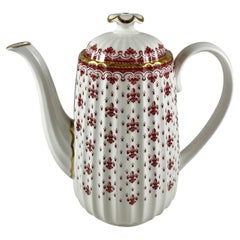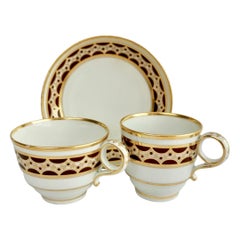Spode Fleur De Lys Red
20th Century English International Style Serving Pieces
Ceramic
20th Century English International Style Serving Pieces
Ceramic
People Also Browsed
Antique 1790s English George III Tea Sets
Porcelain
Antique 1890s German Renaissance Revival Tea Sets
Silver
Antique 1820s British George IV Tea Sets
Sterling Silver
Antique 1890s German Dinner Plates
Porcelain
Antique 1880s Chinese Chinese Export Vases
Porcelain
Antique 1810s English Regency Porcelain
Porcelain
Antique 1810s English Regency Tea Sets
Porcelain
Antique 1830s English Rococo Revival Tea Sets
Porcelain
Antique Late 19th Century British Late Victorian Porcelain
Porcelain
Antique 1820s English Regency Tea Sets
Porcelain
Mid-20th Century Italian Tea Sets
Porcelain
Antique Late 19th Century Rustic Tea Sets
Copper
Antique Mid-19th Century American Aesthetic Movement Sheffield and Silve...
Silver Plate
2010s French Other Porcelain
Porcelain
Antique 1880s English Aesthetic Movement Dinner Plates
Porcelain
Antique 18th Century English Vases
Porcelain
Spode for sale on 1stDibs
Spode is one of the oldest and most distinguished of the great pottery companies of Staffordshire, the time-honored home of English ceramics. The firm’s blue and white bone china transferware is a timeless classic. Spode dishes compose the sort of elegant dinner service that most of us envision on a traditional holiday table.
The company was established in 1770 in Stoke-on-Trent by Josiah Spode, a friend and neighbor of another estimable English ceramist, Josiah Wedgwood. The Wedgwood firm first came to prominence for its tableware, which quickly gained favor in aristocratic households throughout Britain and Europe.
Spode was particularly known for two technical achievements in the firm’s early decades. The first was to develop a standard formula for the making of bone china — a type of porcelain (made with a mixture of bone ash, minerals and clay) that is dazzlingly white and so strong it can be used to create very thin translucent plates and vessels.
The other advancement was to perfect the making of transferware. That process involves the transfer of pictorial images inked on tissue paper — such as the garden scenery in the famous Willow dish patterns — onto ceramics that are then sealed with a glaze.
From the 1820s onward, Spode enjoyed tremendous success both in Britain and elsewhere owing to the beauty and vitality of its decorative imagery. By some counts, Spode created more than 40,000 patterns in the 19th century.
In 1833, following the sudden death of Josiah Spode III, business partner W. T. Copeland took over the company and changed its name to Copeland Spode (it later changed again, this time to W. T. Copeland and Sons). Collectors regard Copeland-marked pieces as Spode china. The Spode brand was revived in 1970.
Many favorite Spode patterns — among them Blue Italian, Indian Tree, Greek and Woodland — date to the company’s early years. Spode’s most popular pattern, Christmas Tree, was introduced in 1938.
Prices for antique and vintage Spode china vary widely, based on the size of the service, its condition and the pattern. An antique dinner service for 12 people or more, in good repair and complete with cups and serving dishes, will generally cost between $10,000 and $20,000. Such Spode services become heirlooms — a proud and timeless addition to a family’s table. And as you will see on these pages, Spode’s rich and varied wares offer a visual feast in and of themselves.
Find Spode serveware, ceramics and decorative objects on 1stDibs.
A Close Look at international-style Furniture
The International Style, a modernist movement within architecture and furniture design that was given its name by American architect Philip Johnson and historian Henry-Russell Hitchcock, was born during the 1920s and ’30s. It gained steam initially in Europe and then in the United States as a response to the first World War. Building projects associated with the movement, as well as vintage International Style chairs, tables and other furnishings, are minimal and pared back.
Pioneers of the International Style — architect Walter Gropius and his Bauhaus colleagues Ludwig Mies van der Rohe and Marcel Breuer, De Stijl advocate and Dutch architect J.J.P. Oud and visionary designer Le Corbusier — stripped away decorative elements and placed considerable value on functionality and clean lines, integrating the use of industrial materials like steel, concrete and large sheets of glass in their work. Quite aptly, this mode of design and architectural style coincided with an era now known as the Machine Age and became a global symbol of modernism. The primary motive of its practitioners was to address the changing needs of a rapidly industrializing society, especially the demand for office complexes and apartments in large cities, through economical, technologically advanced, yet aesthetically pleasing designs for furniture and buildings.
“Space and light and order. Those are the things that men need just as much as they need bread or a place to sleep,” said Le Corbusier of the philosophy behind his practical modernist architecture.
The International Style’s designers and architects were inspired by the advantages afforded them by the era’s new technology and industrial machinery as well as state-of-the-art materials. Le Corbusier was fond of framing his buildings in steel but reinforced concrete made far more economic sense. He is probably most admired for the iconic private homes and commercial buildings that he designed or codesigned with his cousin Pierre Jeanneret, which are spread across the world, from New York City to Paris to Chandigarh, India. Today, Breuer’s Wassily Lounge chair; the elegant LC series created by Le Corbusier, Jeanneret and Charlotte Perriand; and Mies van der Rohe’s Barcelona chair, crafted with his romantic partner, designer Lilly Reich, are emblems of progressive modernist design and all make prominent use of tubular steel. Vintage originals are the prized cornerstone of collections.
“The International Style is probably the first fundamentally original and widely distributed style since the Gothic,” posited Johnson in the book that accompanied “Modern Architecture: International Exhibition,” an architectural show he cocurated with Hitchcock that featured the work of Frank Lloyd Wright, Le Corbusier, Richard Neutra and others. While the term “International Style” had previously been circulating in Europe, when the show opened at the Museum of Modern Art in 1932, it yielded a much broader application of this important style of design.
Find International Style furniture on 1stDibs.
Finding the Right dining-entertaining for You
Your dining room table is a place where stories are shared and personalities shine — why not treat yourself and your guests to the finest antique and vintage glass, silver, ceramics and serveware for your meals?
Just like the people who sit around your table, your serveware has its own stories and will help you create new memories with your friends and loved ones. From ceramic pottery to glass vases, set your table with serving pieces that add even more personality, color and texture to your dining experience.
Invite serveware from around the world to join your table settings. For special occasions, dress up your plates with a striking Imari charger from 19th-century Japan or incorporate Richard Ginori’s Italian porcelain plates into your dining experience. Celebrate the English ritual of afternoon tea with a Japanese tea set and an antique Victorian kettle. No matter how big or small your dining area is, there is room for the stories of many cultures and varied histories, and there are plenty of ways to add pizzazz to your meals.
Add different textures and colors to your table with dinner plates and pitchers of ceramic and silver or a porcelain lidded tureen, a serving dish with side handles that is often used for soups. Although porcelain and ceramic are both made in a kiln, porcelain is made with more refined clay and is more durable than ceramic because it is denser. The latter is ideal for statement pieces — your tall mid-century modern ceramic vase is a guaranteed conversation starter. And while your earthenware or stoneware is maybe better suited to everyday lunches as opposed to the fine bone china you’ve reserved for a holiday meal, handcrafted studio pottery coffee mugs can still be a rich expression of your personal style.
“My motto is ‘Have fun with it,’” says author and celebrated hostess Stephanie Booth Shafran. “It’s yin and yang, high and low, Crate & Barrel with Christofle silver. I like to mix it up — sometimes in the dining room, sometimes on the kitchen banquette, sometimes in the loggia. It transports your guests and makes them feel more comfortable and relaxed.”
Introduce elegance at supper with silver, such as a platter from celebrated Massachusetts silversmith manufacturer Reed and Barton or a regal copper-finish flatware set designed by International Silver Company, another New England company that was incorporated in Meriden, Connecticut, in 1898. By then, Meriden had already earned the nickname “Silver City” for its position as a major hub of silver manufacturing.
At the bar, try a vintage wine cooler to keep bottles cool before serving or an Art Deco decanter and whiskey set for after-dinner drinks — there are many possibilities and no wrong answers for tableware, barware and serveware. Explore an expansive collection of antique and vintage glass, ceramics, silver and serveware today on 1stDibs.



